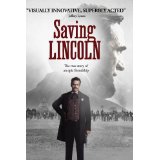We’re almost 150 years removed from the death of Abraham Lincoln, yet interest in the first major assassination in American history appears to be at an all-time high. Daniel Day Lewis just won a well-deserved Oscar for his astounding portrayal of our 16th president, and this month has already seen the home video release of the fascinating Killing Lincoln. Pictures From the Fringe enters the fray with the paradoxically-titled Saving Lincoln, a unique, well-meaning presentation of his presidency and a sketchy portrait of the not-so-well-known relationship between Lincoln and personal bodyguard Ward Hill Lamon.
Lamon, who Lincoln eventually appointed U.S. Marshal of the District of Columbia, was notably absent during the evening of the president’s assassination. (Lincoln had sent Lamon to Richmond as an ambassador promoting Reconstruction.) The film depicts Lamon (Lea Coco) and Lincoln’s (Tom Amandes) first meeting in Illinois — aspiring attorney Lamon looked up to Lincoln — as well as the moment when Lamon names himself the president’s bodyguard after the Baltimore Plot to assassinate Lincoln in 1861 is uncovered. The film proceeds to hit the major signposts in the president’s political/persona life, including the Gettysburg Address and the Emancipation Proclamation. We also watch Lincoln deal with the death of son Willie (Elijah Nelson) from typhoid fever and the carriage accident that injured First Lady Mary Todd Lincoln (Penelope Ann Miller.)
Saving Lincoln seeks to stand out from the suddenly crowded field of Lincoln stories by utilizing vintage photos — including a bunch from the Library of Congress — as the backdrops for each scene, with the actors then being inserted via green screen. Director Salvador Litvak calls this new process “CineCollage”, and I can imagine the effect catching on down the line. (Especially when an enterprising director finds a way to incorporate 3D filmmaking to create a greater sense of depth.) Litvak — working with a relatively modest budget of $700,000 — simply doesn’t pull it off. It’s always very apparent that we’re watching actors (who appear in color) performing in front of some sort of green screen (all of the backgrounds are obviously in black and white). Having these Civil War-era photographs vividly come to life is a terrific idea, but Saving Lincoln is unable to completely transport the viewer.
This visual gimmick, however, is far from the film’s biggest problem. Saving Lincoln bills itself as “the true story of an epic friendship”, but the movie doesn’t give us a very clear picture of Lamon nor does it thoroughly examine his bond with the president. After Lamon and Lincoln’s initial meeting, the film skips ahead about a decade to the Lincoln-Douglas debates of 1858 and Lamon joining the future president on the campaign trail in 1860. Did I mention this all happens within the first 15 minutes? From here, the movie that purports to be about a relatively unknown friendship turns into an inevitably patchwork presentation of Lincoln’s life and career. More time is dedicated to Lincoln’s mounting guilt over the casualties of the Civil War and whether or not he should replace General Ulysses S. Grant. These are obviously both worthy topics, but this film doesn’t seem like the best time to explore them; why not spend more time developing the Lincoln/Lamon relationship, since most people don’t know about it?
Even more problematic is the portrayal of Lamon, who also narrates the events of the film while defending his alleged failings over Lincoln’s dead body. (I’m not kidding.) Besides not depicting any of their time practicing law together — so we never really get to see what ingratiated the men to each other — the film appears to posit that the main reason Lincoln kept Lamon around was because he was handy with a banjo. (At least we get to hear some period folk tunes.) Historical accounts describe Lamon as somewhat of a larger-than-life character, but the movie only hints at this aspect of his personality. At one point, he literally brings a gun to knife fight. Heck, the film’s meatiest scene isn’t even between Lincoln and Lamon; it’s a moment between Lincoln and Elizabeth Keckley (Saidah Arrika Ekulona), who convinces the president he’s an instrument of god.
The performances are more theatrical than cinematic, but they’re passable overall; especially when you consider the unavoidable woodenness that comes from doing all your acting in front of a green screen. (Isn’t that right, everyone in the Star Wars prequels?) Amandes (Everwood) gives us a more emotional, insecure version of Lincoln than we’ve seen recently. Coco (J. Edgar), as mentioned above, doesn’t really have a ton to work with. So he is often reduced to either giving Lincoln admiring looks from the sidelines or narrating heavy-handed lines like, “had I known the blackguard’s true intent, Booth’s eyes would’ve never again beheld the sun” after unwittingly glimpsing the president’s future assassin at his second inauguration. Other familiar faces like Miller (The Shadow), Bruce Davison (X-Men) and Creed Bratton (The Office) also pop up, though Miller is the only one who makes any sort of impression.
On the other hand, I thoroughly enjoyed the premise that Lincoln — with his independent spirit that refused to adhere to any sort of security protocol — was a complete pain in the butt to protect. The president apparently refused to take more aggressive security measures because he was sensitive to accusations of cowardice. I wish the film had focused more on these sorts of insights rather than giving us an ultimately unsatisfying medley of Lincoln’s presidency. Honest Abe once famously said, “The better part of one one’s life consists of friendships.” Saving Lincoln would’ve been more successful if a better part of the movie actually consisted of the friendship between Lamon and the president.



